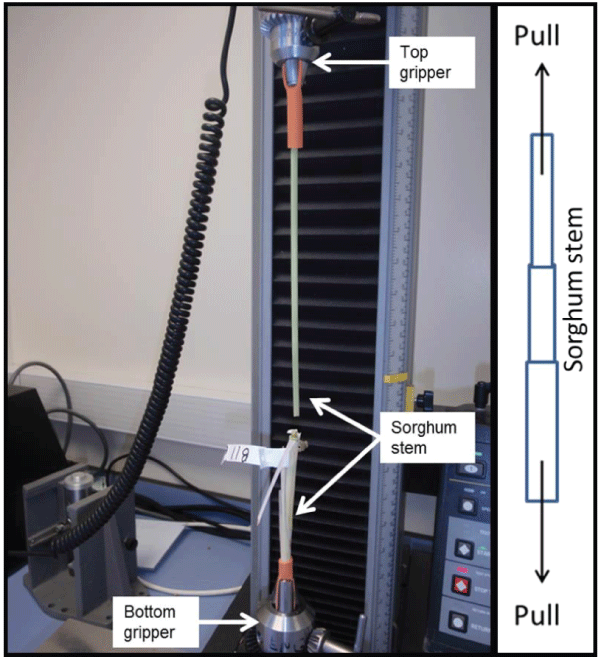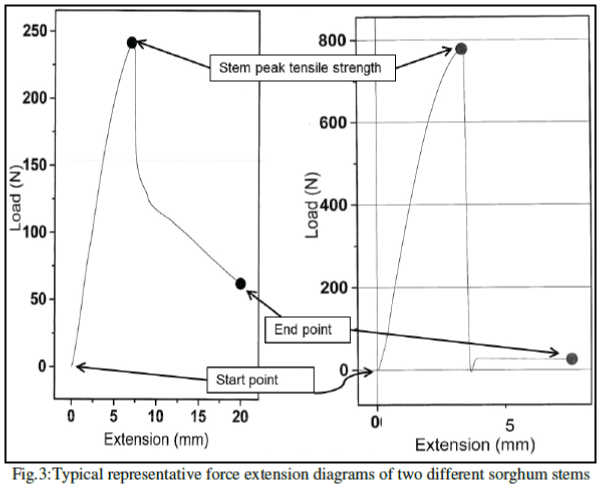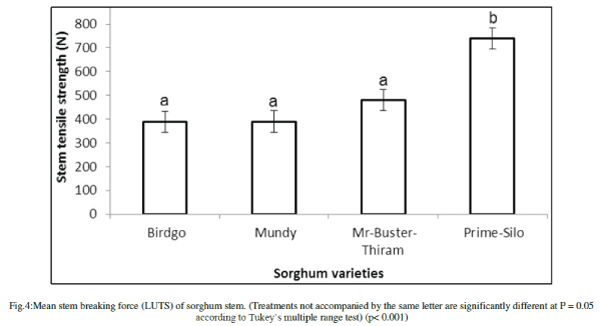ISSN ONLINE(2319-8753)PRINT(2347-6710)
ISSN ONLINE(2319-8753)PRINT(2347-6710)
H.P. MASEBU1, M. J.CROOK2, D. R. WHITE3, R.J. GODWIN4
|
| Related article at Pubmed, Scholar Google |
Visit for more related articles at International Journal of Innovative Research in Science, Engineering and Technology
Sorghum is the staple food of indigenous people of the arid areas of the world because it is adapted to these climatic conditions better than other major cereal crops. The longitudinal ultimate tensile strength of stem for four glass-house grown sorghum varieties namely Birdgo (B), Mr-Buster-Thiram (MBT), Mundy (M) and Prime-Silo (PS) was determined. The magnitude of the stem ultimate tensile strength of the Prime-Silo variety recorded at 739 N was significantly greater than those of the other three varieties namely Birdgo (388 N), Mundy (390 N) and Mr-Buster-Thiram (480 N), these later varieties had no statistical significant difference between them. The mean ultimate tensile strength of stem was 491±127 N. The ultimate tensile strength of roots is higher than that of the stem of the respective varieties. Therefore the plant is most likely to fail through stem separation than through uprooting if exposed to a vertical longitudinal pulling force.
Keywords |
| grain stripping, stem, roots, sorghum head, tensile strength |
INTRODUCTION |
| Sorghum bicolour is a species of sorghum genus of the Andropogoneae family in the plant kingdom[1], is a monocotyledon native of Africa[2],found in the same family branch with such plants as sugar cane and maize[3]. Sorghum production and utilisation of 67 Million tonnes per annum (Mta-1) makes it the fifth most important cereal crop globally after maize (826 Mta-1), rice (686 Mta-1), wheat (683 Mta-1) and barley (155 Mta-1)[4],[5]-[6]. Sorghum which has realised a steady increase in utilisation between the years 1961 – 2003 is the staple food grain for at least 750 million inhabitants of the semi-arid tropics of Africa where it is the second most important crop after maize, and in India where it is the third most important crop after rice and wheat[6],[7].Data and information on engineering properties of cropsand produce is paramount and sought in proper planning and commissioning of machinery and processing systems. A lack of crop specific informationresultsin complications and failure to achieve successful design and implementation of specific machinery leading to improvisation by using equipment, process and system original intended for other products resulting in reduced efficiency unlike when the right input would have been used.The data on the longitudinal tensile strength of the sorghum stem is useful when working with stripper harvesting. The concept of stripper harvesting works by stripping the top grain rich material of the panicle. It differs from the conventional harvester in that it has a spinning drum with stripping tools attached on the periphery of the drum in place of the cutter-bar. The stripping tools attached on the drum periphery have a v-notch shaped edges that strip the grain off the head. This drum-stripping-tools assembly rotate up and backwards in relation to the forward driving wheels of the harvesting machine it is mounted on. In the process of stripping the crop from the roots through the stem to the panicle will be put in tension by the upward pulling forces of the stripping tools on the grain head and the opposite and resistance force provided by the roots anchored on the ground. If the roots are not strong enough the whole plant will be uprooted, or if the stem is weak it may also break, both these failures will result in either overloading the threshing machine with straw or material other than grain (MOG). This will defeat the purpose of stripper harvesting where grain rich material is taken into the thresher unit minimising or limiting the amount MOG that can be fed into the threshing chamber. This is reputed to save fuel and increase machine productivity. With this understanding the objective to investigate the longitudinal ultimate tensile strength(LUTS) of the stem was drawn. |
MATERIALS AND METHOD |
| A. CROP AVAILABILITY |
| Seeds of the four sorghum varieties used in this experiment were sourced from the UK seed suppliers. These varieties were Birdgo, Mr Buster-Thiram, Mundy and Prime-Silo, and were the only that were available from the suppliers in the UK. A pot experiment was conducted inside the glasshouses at Harper Adams University. The experiment was laid out in a completely randomised block design. The plants were grown in four blocks of twenty plants each. Each variety had five plants grown in sandy loam (80%) mixed with commercial compost (20%) volume basis per block. The use of compost was to alleviate the collapse of the sandy loam during the growing period. A total of 80 plants were used in this study. The sorghum stems were left to fully mature and were collected at full grain stage. The laboratory studies were carried out at Harper Adams University located in Shropshire in the United Kingdom. |
| B. THE MECHANICAL TESTING |
| Strength testing machine brand name Instron, model 5543 was used to determine tensile forces. The instrument consisted of a loading platform/frame, 1000 N maximum load cell, a control panel, a monitor, electronic control module and a central processing unit. The maximum linear speed of the Instron was 1000 mm/minute, and this was the speed used for this study. This speed was used because it was the maximum speed provided in the Instron machine testing platform which is still lower than the actual speed of the stripping mechanism as determined from the relationship (linear speed(Ãâõ) = radius(r)*rotational speed(ω)) then the linear speed of the stripping mechanism ranges between 4.5 and 18.6m/s at speeds of 120rpm and 500rpm respectively of the static stripper rig to be used in the associated experiment. |
| C. CLAMPING OF SAMPLES TO THE TEST PLATFORM |
| Adapted clamps made from modified drill chucks and some from sets of jubilee clips were used to secure samples for the tests, and to further enhance gripping flexible rubber tubes of various sizes (8 – 15 mm internal diameter) depending on the size of the sample were slid between the clamp and the sorghum stem samples (Fig. 1) to ensure that the sample will not slip out of the grip during the experiment(pulling). In the middle a steel wire rod (2 – 10 mm in diameter) was inserted to ensure that the sample will not be crushed and collapse inwards during clamping. |
 |
| D. SORGHUM STEM TENSILE STRENGTH |
| The sorghum stem was cut about 20 cm above the ground level to leave a piece of stump that was later used for testing the roots tensile strength. From the top it was cut at about 15 cm below the head just above the top most joint that joins the peduncle to the rest of the plant. The stems varied in length between 50 cm and 80 cm depending on the initial height of the plant. The stem was attached to the Instron 5543machine by the sample claps described above, and pulled apart along the longitudinal axis until it fails (Fig. 2). After the stem breaking/yielding point the machine was stopped and the failure characteristics data obtained. |
 |
| Fig.2: Sorghum stem failure at the peduncle joint (showing bottom and top grippers with a sample just finished testing, orange rubber tubes to aid sample gripping). |
| E. DATA ANALYSIS |
| The obtained data were checked for normality and transformed when required and then subjected to analysis of variance (ANOVA) in Genstat using Tukey’s multiple range test. A single factor ANOVA set at a significance of P=0.05 was used to compare the ultimate tensile strength of the roots.Differences in ultimate tensile strength of the roots were indicated using standard errors of means. |
RESULTS AND DISCUSSION |
| F. FORCE-EXTENSION DIAGRAMS FOR THE SORGHUM STEM FAILURE |
| Fig. 3 shows a plot of the loading characteristics of a sorghum stem resistance curve. The first part of the curve shows an upward slope which indicates the loading or resistance phase before the sample breaks/fails at the LongitudinalUltimate Tensile Strength (LUTS)force. The peak indicates the position of the maximum load rating of a given stem. The peak point is the LUTS (N) of the stem. |
 |
| G. SORGHUM STEM TENSILE STRENGTH |
| The effect of sorghum variety on the tensile strength of the stem was found to be highly significant (p < 0.001). The magnitude of the stem ultimate tensile strength of the Prime-Silo variety recorded at 739 N was significantly greater than those of the other three varieties namely Birdgo (388 N), Mundy (390 N) and Mr-Buster-Thiram (480 N). These three latter varieties were found to have no significant difference at 95% C.I. level using Tukey’smultiple range test (Fig. 4).The study on the mean Longitudinalultimate tensile strength of the stem found that it varies with different sorghum varieties. Prime-Silo which had visibly the largest stem also had the highest mean ultimate tensile strength. The stems mainly broke towards the top where it was thinnest and in a joint where a secondary tiller had developed. Single stems without tillers had the highest tensile strengths. |
| If the sorghum plant is exposed to the longitudinal tensile strength the plant is most likely to fail by the stem separation than the plant uprooting, this is because the longitudinal tensile strength of itsroots [8],[9] is higher than the mean longitudinal ultimate tensile strength of its stem of the same variety as in Fig. 5. In tension the roots are stronger than the stem. The longitudinal tensile strengths of the Birdgo variety’s roots and stem are 511N and 388N respectively, whilst for Mundy variety is 1013N for roots and 390N for the stem. Mr-Buster-Thiram sorghum variety LUTS of the roots is 725N which is greater than 480N strength of its stem. Finally variety prime-silo’s mean roots strength was reported at 1323N also higher than 739N reported for its stem strength. Stem strength of different were also different, this is because different varieties tend to differ in some a number aspects physical characteristics, some were bigger like Prime-Silo and some were smaller like Birdgo. |
 |
CONCLUSION |
| The study found that: The mean longitudinal ultimate tensile strength of the sorghum stem of the four varieties were491 N. Different varieties returneddifferinglongitudinal ultimate tensile strength of the stem. The stems tend to fail towards the top where it was thinner and in the tiller joints which were weakened by the development of tillers.The sorghum plant is most likely to fail by stem separation than through uprooting if exposed to tensile forces pulling from the top like in grain stripping setup.It is recommended that the longitudinal tensile strength of the sorghum head paniclesof the same varieties be documented to offer a complete strength profile of the sorghum plant from roots, stem and panicles. |
ACKNOWLEDGEMENT |
| Gratitude to the government of the Republic of Botswana, for financing this research study. Also thanks to Harper-Adams University for provision of facilities for carrying out this study. |
References |
|